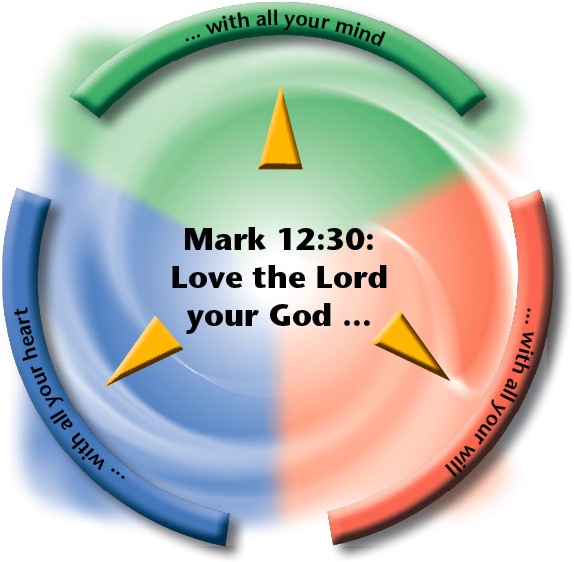W
hile it can be confusing to present Jesus as a model for each of the individual styles (see page 31), without a doubt, Jesus taught—and practiced—the very concerns incorporated into the Trinitarian Compass. Did Jesus, then, teach the “three colors?” He certainly did, and he did it both in his words and his deeds.
A prime example is Jesus‘ answer to the teacher of the law, who asked him for the “greatest commandment” (Mk. 12:28-31). This question—and the answer Jesus provided—is at the center of the whole biblical message. Jesus‘ answer is: “Hear, O Israel, the Lord our God, the Lord is one. Love the Lord your God with all your heart and with all your will and with all your mind and with all your strength. The second is this: Love your neighbor as yourself.”
 In Mark 12:30 Jesus answers the question about the “greatest commandment” by stressing that we should love God with all our heart (blue), with all our will (red), and with all our mind (green). And we should do that with “all our strength.” In other words: not a little bit of our heart, or a little bit of our will, or a little bit of our mind, but a balance of all three that displays that we have invested all we have in every single area (yellow arrows).
In Mark 12:30 Jesus answers the question about the “greatest commandment” by stressing that we should love God with all our heart (blue), with all our will (red), and with all our mind (green). And we should do that with “all our strength.” In other words: not a little bit of our heart, or a little bit of our will, or a little bit of our mind, but a balance of all three that displays that we have invested all we have in every single area (yellow arrows).
Further topics in the above chapter of the full version of the book
The creed that God is one - The first part: Loving God - The second part: Love your neighbor - How do the spiritual styles relate to the "Jesus rule"? - Practical consequences

